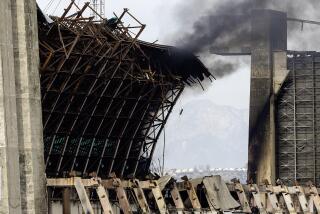Tustin : Marine Corps Submits Jet-Fuel Cleanup Plan
- Share via
Officials at the Tustin Marine Corps Helicopter Air Station proposed encircling jet-fuel saturated soil at the base with an impermeable 18-foot-deep clay barrier and continued treatment of contaminated water seeping from the site in a long-awaited cleanup plan submitted Monday.
The proposal, one of several alternatives outlined by an architectural and engineering firm for base officials, is designed to halt migration of toxic hydrocarbons into the ground water and a nearby flood-control channel that feeds into the Upper Newport Bay wildlife reserve.
James Bennett, executive officer for the Santa Ana Regional Water Quality Control Board, said the staff would review the proposal and make recommendations for the board to consider at its December meeting.
Meanwhile, Steve McDonald, environmental director for the El Toro and Tustin Marine bases, said construction of interim facilities to prevent further seepage of contaminants is under way, including lining an 825-foot stretch of Peters Canyon wash with concrete. The regional board has set a Dec. 15 deadline for completion of remedial measures.
The interim plan, designed to beat the onslaught of winter rains, also includes a special drain system to divert water to a collection basin for treatment to remove pollutants. McDonald estimated that the interim measures would cost about $470,000.
He said the concrete liner and drain system would be part of the long-term cleanup plan, estimated to cost an additional $375,000. The clay barrier--a 2-foot-wide, 1,351-foot-long trench--would enclose a 23,500-square-yard area saturated with jet fuel from the two burning pits.
The pits were used for fire-training exercises from 1970 to 1983, when county environmental officials discovered contaminants seeping into the Peters Canyon wash.
McDonald estimated that it would take up to one year after the regional board approved a cleanup plan for actual construction to begin.
More to Read
Sign up for Essential California
The most important California stories and recommendations in your inbox every morning.
You may occasionally receive promotional content from the Los Angeles Times.













